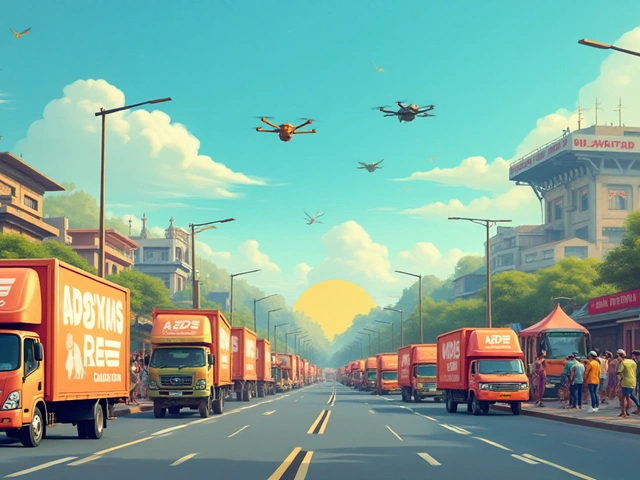Warehouse closures? Not exactly what you’d expect from a giant like Amazon, right? Everyone’s so used to seeing those iconic blue vans zipping down the street, speedy packages on deck. But lately, Amazon’s been picking up headlines for something else: shutting the doors on dozens of its giant warehouses across America and Europe. So, what’s up? Is the e-commerce king losing steam, or is there something bigger at play?
Here’s the first thing you need to know: these closures aren’t just about cutting costs. Amazon is making big moves to upgrade how it stores and ships your stuff. Believe it or not, a lot of this comes down to software—yep, that unseen tech behind the scenes that decides where your phone charger or coffee maker sits before it lands at your door. With new systems rolling out, Amazon doesn’t need as many buildings (or workers) to handle the same load. Pretty wild, right?
If you’re running a business or just curious how your next Prime delivery happens, there’s a lot to learn from what Amazon’s doing now. It’s not just about robots and algorithms—it’s the whole backbone of modern logistics getting a shake-up, and the ripple effects matter to everyone, from delivery drivers to mom-and-pop shops. Stick around as we pull back the curtain on why the world’s biggest retailer is rethinking its approach—and what it means for anyone counting on fast, reliable shipping.
- A Surge in Amazon Warehouse Closures
- How Evolving Technology Fuels the Shutdowns
- The Role of Logistics Software in Streamlining Operations
- What This Means for Workers and Local Economies
- Tips for Businesses Navigating a Changing Supply Chain
- The Big Picture: What’s Next for Warehouse Logistics?
A Surge in Amazon Warehouse Closures
It’s not just a handful of buildings—Amazon has been shutting down dozens of warehouses since the start of 2023. The numbers are eye-opening: over 60 closures announced in North America and Europe, with at least 25 facilities set to close permanently in the U.S. alone. These range from massive fulfillment centers to smaller delivery stations that handle last-mile shipping. Some closures were planned from the start, but others took employees and local officials by surprise, especially in places where Amazon was one of the top employers.
Why is this happening now? The simple answer is overexpansion. During the 2020 boom, Amazon ramped up its workforce and built more warehouses than ever to keep up with the explosion in online shopping. But as in-person shopping came back and the rush died down, a lot of those extra buildings just weren’t needed anymore. It’s a classic case of scaling fast, then having to pull back when demand levels out.
Here’s a look at how this surge compares with just a few years ago:
| Year | Amazon Warehouse Closures (US & Europe) |
|---|---|
| 2020 | 3 |
| 2022 | 18 |
| 2023 | 40+ |
| 2024* | 25 (announced, projected to rise) |
*as of April 2024
Of course, this isn’t just about empty space. For tons of employees, contractors, and nearby businesses, a shuttered Amazon site can mean lost jobs and fewer local customers. But from Amazon’s point of view, it’s part of getting leaner, faster, and more tech-savvy—especially as new logistics software lets them do more with fewer physical locations. Think of it as fine-tuning the supply chain to fit today’s shopping habits and make their whole delivery network cheaper to run.
How Evolving Technology Fuels the Shutdowns
It’s not just the economy or changing consumer habits that are shuttering so many Amazon warehouses—it’s newer and slicker tech. Over the last few years, Amazon has doubled down on upgrading its logistics game with smarter systems, robots, and artificial intelligence. Stuff that was once sorted by hand or with endless conveyor belts is now handled by machines and real-time software, cutting down on the need for so much extra space.
If you pop the hood on Amazon’s warehouse network today, you’ll find high-tech robots moving shelves of products, automated picking arms, and a ton of sensors tracking every item. These robots and new logistics software don’t just make things faster—they help Amazon pack more inventory into smaller spaces, predict what people will buy, and send stuff out with almost zero mistakes. What does that mean? Amazon can do the same—or more—with fewer, better-equipped buildings.
Another big thing: cloud-based logistics software is making a huge difference. These programs can analyze mountains of data in a blink. They figure out where inventory should be, which warehouse is closest to you, and even anticipate spikes in demand. Sometimes, this means that older, less efficient warehouses just aren’t needed anymore. The newer buildings, boosted by better tech, take over most of the heavy lifting.
Let’s look at how automation has impacted Amazon’s warehouse network lately:
| Year | Warehouses With Major Automation | Total US Warehouses |
|---|---|---|
| 2020 | ~135 | Approx. 175 |
| 2023 | ~178 | Approx. 170 |
See how the number of automated sites jumps while the total warehouse count is stable or even dropping? That shows how much efficiency matters now. Older sites in remote spots or places with duplicate coverage are the first to go. Amazon isn’t the only company moving this way, but since it’s got the biggest footprint, its choices set the pace for other e-commerce and supply chain players.
For anyone working in supply chain, or running a business that relies on Amazon delivery, this is your wake-up call. The world of warehouse logistics is shifting under everyone’s feet—being nimble with logistics software and automation isn’t optional, it’s becoming the new normal. If you haven’t started looking at fresh tech for your own systems, now’s the time.
The Role of Logistics Software in Streamlining Operations
When you think of Amazon warehouses, you probably imagine endless shelves and a swarm of yellow robots. But the real secret sauce is behind the scenes: next-level logistics software. It’s not just about automating tasks—these programs make each step of order fulfillment much faster, smarter, and more precise. And that’s a huge reason Amazon can close so many warehouses and still get you your stuff in days, sometimes hours.
Amazon’s system connects every part of its operation—from supplier shipments to which worker grabs your headphones off the shelf. Their in-house system, called Amazon Robotics Fulfillment Engine, uses real-time data to make decisions about inventory placement, restocking, and packing orders. It can even predict which products will sell more in certain regions, so those items are stored closer to customers. This slashes delivery times and trims extra costs.
But Amazon isn’t the only player using these tools. Lots of companies now tap into advanced logistics software like Manhattan Associates, Oracle, and JDA to get similar results. These platforms help with:
- Tracking shipments in real time, so lost crates or delays get spotted instantly.
- Managing warehouse layouts for maximum efficiency—no wasted shelf space.
- Forecasting demand to avoid stockouts or piles of unsold goods gathering dust.
- Automating repetitive jobs, so humans can focus on problems that need real thinking.
Want some perspective? The rise of smarter logistics software is one main reason retail giants need fewer physical warehouses, even when online orders are skyrocketing. According to a 2023 logistics report, companies using end-to-end warehouse management systems cut average picking times by nearly 30% compared to older, manual setups. That’s like turning eleven-hour workdays into eight-hour ones without losing output.
| Software Used | Average Picking Time Saved |
|---|---|
| Amazon Robotics Fulfillment Engine | ~35% |
| Manhattan Associates WMS | ~28% |
| Oracle SCM Cloud | ~25% |
For businesses, skipping the software just doesn't make sense anymore. If you’re not already diving into automation, you risk falling behind—fast. It’s not just about surviving; it’s about shipping faster, saving money, and keeping up with customer expectations for super-speedy delivery. Amazon is just showing everyone what’s possible when tech leads the way.

What This Means for Workers and Local Economies
Warehouse shutdowns hit more than just the bottom line—they shake up local jobs fast. Every time Amazon locks up a site, hundreds (sometimes thousands) of warehouse workers and contractors face sudden job loss. In 2024 alone, over 12,000 Amazon workers worldwide were directly impacted by Amazon warehouses closing, according to CNBC. Those jobs don’t always shift neatly to other sites, especially in rural communities where Amazon might have been the largest employer.
The blow isn't just to the workers on the floor. Local businesses who supplied goods and services to these big warehouses—think cleaning companies, food trucks, logistics truckers—feel that pinch too. Suddenly, there's less demand for everything from janitorial work to local transportation. Once-busy areas around these sites can see a slowdown in everything from gas sales to rental housing.
On the flip side, some workers do get offers to move to other Amazon sites, but that can mean uprooting families or facing a far longer commute. There’s no guarantee new positions will open fast, especially as more warehouse operations get automated and streamlined through stronger logistics software.
So, what should folks do? Here are some practical steps if you or your community’s affected by a warehouse closure:
- Stay connected with local workforce agencies—they often set up job fairs or training for affected workers when a big employer pulls out.
- Use Amazon’s announced retraining or relocation programs if available. The company has offered upskilling for tech and logistics roles at bigger hubs.
- Local leaders should work with state programs to attract new logistics or tech firms to reuse existing warehouse space and infrastructure.
Curious about just how many jobs and dollars are in play? Here’s a quick look:
| Warehouse Size | Jobs Lost Per Closure | Estimated Local Economic Impact |
|---|---|---|
| Small (under 200,000 sqft) | 200-400 | $6M–$10M/year |
| Medium (200,000–700,000 sqft) | 500-1,200 | $20M–$40M/year |
| Large (700,000+ sqft) | 1,500+ | $50M+/year |
Bottom line: Amazon warehouse closures send out shockwaves, but communities can cushion the blow if they stay proactive, keep resources moving, and look for ways to bring in new opportunities. It’s a tough shakeup, but also a push to rethink how towns bounce back when the big guys leave.
Tips for Businesses Navigating a Changing Supply Chain
It’s not just Amazon warehouses getting a shake-up—every business using storage and shipping is feeling the heat. With logistics software getting smarter, here’s what you can do to avoid getting left behind.
- Upgrade Your Tech. If your system runs on buckets of spreadsheets, it’s time to rethink. Look for software that matches how you run things—whether it’s inventory tracking, smart forecasting, or real-time order updates. Cloud-based options mean you don’t need a whole IT team, either.
- Get Real with Data. Don’t fly blind. Even small businesses can track sales, returns, and even delivery blips. Knowing what’s selling (and what isn’t) helps adjust fast—especially when supply chain hiccups happen. One study showed companies using data-driven logistics cut supply chain costs by up to 15%.
- Build Stronger Relationships. Shifts like Amazon warehouse closures put pressure on smaller logistics partners. If you ship with third parties, stay in touch—changes on their end could sneak up and mess with your own delivery promises.
- Rethink Your Storage Game. Don’t be afraid to mix things up—using a mix of regional warehouses and on-demand solutions can help cushion against delays caused by industry changes. Flexible contracts can be a lifesaver if you need to pivot fast.
- Train Your Team. If you roll out new logistics software, don’t just leave workers to figure it out. Hands-on training boosts adoption and helps avoid mistakes during busy seasons.
To put things into perspective, check out these real numbers from 2024 showing how digital upgrades impact performance:
| Strategy | Reported Benefit |
|---|---|
| Automated inventory systems | Up to 35% fewer stock outs |
| Real-time order tracking | 20% drop in support tickets |
| Cloud-based supply chain tools | Average delivery speed up by 18% |
Every step you take to modernize helps you respond faster and keeps your business moving even when big players like Amazon make big moves. Stay curious, keep an eye on industry updates, and don’t be afraid to ask your vendors for new features that actually help.
The Big Picture: What’s Next for Warehouse Logistics?
The closure of so many Amazon warehouses shows just how fast the whole warehouse logistics game is changing. Sure, saving money is a part of it, but the real power move is all about making every step of the supply chain more efficient. Logistics software has gotten so smart that Amazon can reroute packages, predict demand, and juggle inventory like never before. That means fewer buildings, but each one runs way smoother—almost like a game of Tetris that never gets stuck.
Experts in the industry say this is just the tip of the iceberg. Over the next few years, expect to see:
- Even smarter AI systems making real-time decisions for shipping and storage
- More robots and automated tools handling jobs once done by humans (think robotic arms picking and packing goods)
- Flexible warehouse networks—big companies won’t need as many giant buildings, but smaller, easy-to-move centers could pop up closer to big cities
- Faster shipping in crowded urban areas, but possibly longer waits for rural spots as operations get more centralized
One eye-opener: a 2024 logistics survey showed that 68% of big retailers are already investing in new software to track inventory and speed up deliveries. Amazon’s not alone here—Walmart and Target are following the same trend, just with their own twist.
So what does this mean for people and companies? If you’re a business owner, keeping your tech up to date suddenly matters more than ever. Investing in the right logistics software can mean the difference between same-day delivery and losing customers to a competitor. For everyday shoppers, this wave of change is why that last-minute birthday gift can still show up on your doorstep tonight, not next week.
Fast-forward a few years and the warehouse of the future will probably look nothing like today’s—fewer workers, more robots, and way more brainpower hidden in the cloud. Staying ahead will mean staying flexible, and that’s true for everyone from tech startups to giant retailers like Amazon.





